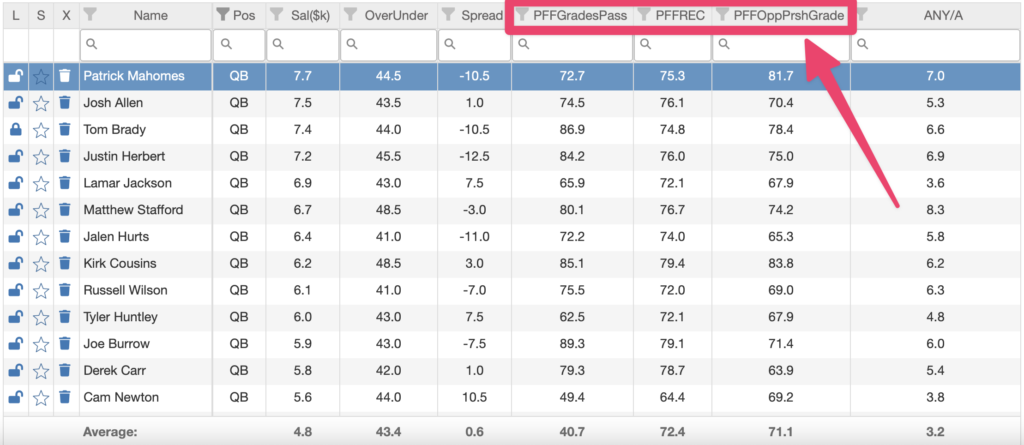In a sea of players to choose from, comparing Pro Football Focus player grades is a powerful way to find value. Here’s a quick overview on which ones we use.
First off, if you’re not familiar with them, see this link for a full explanation of PFF Grades.
In a nutshell, PFF grades are metrics compiled by the professional analysts at Pro Football Focus. Their purpose is to tell you how good a player or team is, relative to other players or teams.
Here’s an example of how PFF grades appear in DFS Hub’s NFL lineup builder.

You can see all the grades in our DFS Field Dictionary. They all start with “PFF.” These fields are available to all DFS Hub Pro members.
Which PFF grade should I use?
The lineup builder lets you choose from dozens of Pro Football Focus grades, but here are the most popular ones, by position:
Quarterback (QB)
- PFFGradesPass — The grade for a QB’s passing ability
- PFFGradesRunPassingSummary — The grade for a QB’s running ability
- PFFREC — The grade for a QB’s receivers
- PFFPBLKA DFS Hub field that represents Pro Football Focus's (PFF's) grade for a team's pash blocking effectiveness. For more, see:
• PFFgrades
More — The grade for a QB’s pass blockers - PFFOppCovGrade — The grade for the opposing defense’s coverage unit
- PFFOppPrshGrade — The grade for the opposing defense’s pass rush
Running Back (RB)
- PFFGradesRunRushingSummary — The grade for a RB’s running prowess
- PFFGradesPassRouteRushingSummary — The grade for a RB’s ability to run passing routes
- PFFRBLKA DFS Hub field that represents Pro Football Focus's (PFF's) grade for an offenses' run blocking effectiveness. For more, see:
• PFF grades
More — The grade for a RB’s run blockers - PFFOppRdefGrade — The grade for opposing defense’s run defense
Wide Receiver (WR)
- PFFGradesOffenseReceivingSummary — The grade for a WR’s overall ability
- PFFPASS — The grade for the passing attack (predominantly the quarterback)
- PFFOppCovGrade — The grade for the opposing defense’s coverage unit
Tight End (TE)
- PFFGradesOffenseReceivingSummary — The grade for a TE’s overall ability
- PFFPASS — The grade for the passing attack (predominantly the quarterback)
Defense (DST)
- PFFDEF — The grade for the overall defense
- PFFPRSHA DFS Hub field that represents Pro Football Focus's (PFF's) grade for a team's pash rushing effectiveness. For more, see:
• PFF grades
More — The grade for the defense’s pass rush - PFFOppOffGrade — The grade for the opposing offense (overall)
- PFFOppPassGrade — The grade for the opposing offense’s passing attack
- PFFOppRushGrade — The grade for the opposing offense’s rushing attack
Team Offense
- PFFOFF — The grade for a player’s overall defense
How PFF grades build better daily fantasy lineups
There are several ways we use PFF grades to build better NFL DFS lineups. For example:
- When two players are close in most other aspects, including salary and projected opportunities, PFF grades can be a powerful tie breaker.
- When choosing a QB, consider the difference between his team’s pass blocking grade [PFFPBLKA DFS Hub field that represents Pro Football Focus's (PFF's) grade for a team's pash blocking effectiveness. For more, see:
• PFFgrades
More] and the opponent’s pass rush grade [PFFOppPrshGrade]. Also weigh the team’s receiver grade [PFFREC] and the opposing coverage unit grade [PFFOppCovGrade]. - When evaluating a running back, consider the difference between his team’s run blocking grade [PFFRBLKA DFS Hub field that represents Pro Football Focus's (PFF's) grade for an offenses' run blocking effectiveness. For more, see:
• PFF grades
More] and the opponent’s run defense grade [PFFOppRdefGrade]. - For receivers, look for a mismatch between the player’s overall offensive grade [PFFGradesOffenseReceivingSummary] and the opponent’s coverage grade [PFFOppCovGrade].
- When choosing a defense (DST), you want to see a mismatch between a team’s defensive grade overall [PFFDEF] and the opponent’s overall offensive grade [PFFOppOffGrade]. A high pass rush grade [PFFPRSHA DFS Hub field that represents Pro Football Focus's (PFF's) grade for a team's pash rushing effectiveness. For more, see:
• PFF grades
More] is preferred, so as to maximize the chance of turnover-related points and reduce offensive scoring.
Pro Football Focus grades are put out by one of the credible statistical agencies in the NFL. Use them to your advantage whenever traditional statistical measures leave ambiguity in your player or team evaluation.


